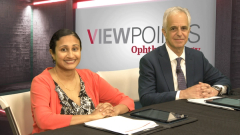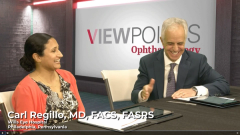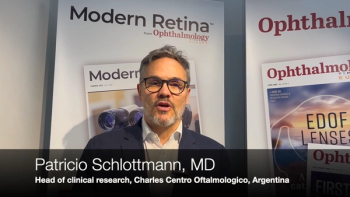
Faricimab Loading Dose Adherence in DME Therapy
Drs Nathan Steinle, Adrienne Scott, Carl Regillo, and Prethy Rao comment on loading dose recommendations for faricimab or other anti-VEGF therapies in the treatment of DME.
Episodes in this series

Nathan Steinle, MD: Back to faricimab, we talked earlier about loading doses. I’m really curious, Dr Rao, the question is coming your way this time. In the trials, they had loading doses, and on-label you had to do 4 loading doses or 6 loading doses of faricimab, then move on to extended therapy. What do you do with your DME [diabetic macular edema] population? Do you load these patients?
Prethy Rao, MD, MPH: No, I don’t. I mean I do….
Nathan Steinle, MD: Dr Scott is getting mad.
Prethy Rao, MD, MPH: The purist, I’m a bit afraid. Along with the disease state of these patients is the treatment burden and having a bunch of other appointments for them to get to. I stick with my previous approach of 3 doses in a row, and then I’ll start to extend them a bit further. But I think 6 might be a little harder in the diabetic population because you want to build trust with the patient as well, and you don’t want them to be on this injection train of, oh man, this is happening forever. That’s 6 months of treatment, and they have to get to their other appointments, so I stick with 3.
Carl Regillo, MD, FACS, FASRS: Although I agree with you, there’s no fixed induction. The unfortunate reality is DME is a slower responding condition, and you often do need monthly treatments for 4, 5, 6 injections, and so I don’t want to start extending until I think the macula is as good as it’s going to get. Unfortunately, DME is particularly treatment heavy in that first year. That slower response, it’s never 1 and done. Very rarely do you get the wow effect from a severely thickened edematous macula to a beautiful macula after just 1 or 2 injections.
Nathan Steinle, MD: Loading doses for DME, how do you approach it?
Adrienne Scott, MD: Similarly, I’m not as stringent with this population as I am with patients with wet AMD [age-related macular degeneration]. Some of that is logistical. These are patients who, again, benefit from, they are not retired like our patients with wet AMD often are. So, I try to, similar I think to what Dr Regillo was describing, treat until I feel like the macula is fairly fluid free, or as fluid free as we’re going to get them, and then I start extending them out. But I tell them, we’re going to put in the work together the first year or two of treatment, and then after that, we can enjoy some of the benefits of maybe less treatment interval. But part of bringing them back is how I’m learning about their eye, and I’m learning about their disease process, and who’s going to need more treatment, and who you can be a bit more lenient with the visit. I’m learning about them, and having them back is teaching me how their eye is responding.
Nathan Steinle, MD: Oh, that’s fantastic. It’s really good insight.
Carl Regillo, MD, FACS, FASRS: Let’s not forget the systemic aspect of this disease. Every visit, I often tell the patient, we’ll do our part, you’ve got to do your part in between the visits, which means getting your blood sugars under the best possible control. Because if their diabetes management is not on par and their A1C [glycated hemoglobin] is super high, it works against us for sure. And that will lead to DR [diabetic retinopathy] progression and other potential vision-threatening complications, proliferative disease, hemorrhaging, and all.
Nathan Steinle, MD: In the trials, they had this magical number of 325 μm, and you could extend once you got below 325 μm. I must admit, I hardly look at the numbers at my clinic. I look at morphology. How about you guys, do you look at numbers or do you look at…?
Carl Regillo, MD, FACS, FASRS: Morphology.
Nathan Steinle, MD: Morphology?
Prethy Rao, MD, MPH: Yes, and I look at the percentage change.
Nathan Steinle, MD: Interesting.
Prethy Rao, MD, MPH: I look at the numbers in terms of gauging their treatment. If I feel like after maybe 3 or 4 that we’re having less than 10% reduction or 10% to 15% reduction in fluid, then maybe that helps guide me in terms of switching them a lot faster. It’d be interesting to see what your thoughts are, but I tend to switch these patients faster when I don’t get a great response because I do want that durability effect. And so, for a lot of these patients, it’s difficult to make the appointment, so I would like to see an effect a bit sooner to be able to help them.
Nathan Steinle, MD: Yes, it’s a good question.Do you switch quicker?
Adrienne Scott, MD: Yes. I was thinking about the central subfield metrics, and I use them when I’m deciding whether to initiate treatment. Then I look at morphology as the treatment process goes on and how much you’re responding. But that threshold, to me says, OK we need to seriously think about treatment, and I will look at the central subfield. And the thickness map is, again, I think a great teaching tool for the patient and the family.
Nathan Steinle, MD: So, they have that buy-in. It makes sense.
Transcript edited for clarity
Newsletter
Keep your retina practice on the forefront—subscribe for expert analysis and emerging trends in retinal disease management.


























































